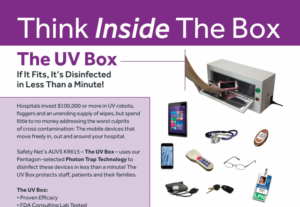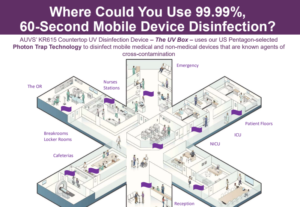Targeted UV Disinfection
Filling the Gaps in Your Infection Prevention Protocol
 How does The UV Box work? Plug the unit into a 110 volt standard outlet, turn the power switch on and a green light illuminates. Turn the knob and open the door and place the item to be decontaminated into the box. Close and lock the door, press the red button (lights up during the 55 second cycle). When the red light goes off, decontamination is done. You might notice a slight ozone smell when the cycle is complete. Can I put anything in The UV Box? Yes, it will not harm electronics. Devices from smart phones to iPad tablets, glucose monitors, cables and lead wires, stethoscopes, BP cuffs, temperature probes, personal items, etc. and all go in the box.
How does The UV Box work? Plug the unit into a 110 volt standard outlet, turn the power switch on and a green light illuminates. Turn the knob and open the door and place the item to be decontaminated into the box. Close and lock the door, press the red button (lights up during the 55 second cycle). When the red light goes off, decontamination is done. You might notice a slight ozone smell when the cycle is complete. Can I put anything in The UV Box? Yes, it will not harm electronics. Devices from smart phones to iPad tablets, glucose monitors, cables and lead wires, stethoscopes, BP cuffs, temperature probes, personal items, etc. and all go in the box.
High-touch medical and non-medical devices that move in, out and around your hospital including smart phones and tablets are a proven source of cross contamination and Hospital Acquired Infections.
SPH Medical and AUVS let you put the solution at the source with the KR615 Germicidal Enclosure.
Becoming widely referred to as The UV Box, the SPH Medical AUVS KR615 fills the gaps in your Infection Prevention Protocol, working continuously between terminal cleanings and providing a better option than wipes.
Patented UV technology delivers a kill rate greater than or equal to 99.99% for the toughest contaminants including MRSA and C. diff. spores.
Decontaminate & Sanitize
- Cell Phones and Tablets
- Stethoscopes
- Blood Pressure Cuffs
- Nurse Calls
- Call Cords
- TV Remote Controls
- Pillow Speakers
- EKG Wires
- Laryngoscope Handles
- Blood Glucose Meters
- Electric Thermometers
- Oximeter Sensors
- Vacuum Regulators
- Ultrasound Transducers
AUVS: Science, Experience and Innovation
Drug-resistant superbugs associated with HAIs are killed by the destructive effects of the UV 254 nm germicidal wavelength used in the SPH Medical AUVS KR615.
Dr. Wayne Clark, a recognized expert in germicidal UV applications, developed the KR615 specifically to address the spread of infection in healthcare environments.
He holds multiple patents and has been contracted by the Department of Advanced Research Projects Agency (DARPA) for the Pentagon’s Immune Building program to address threats of bio-terrorism in air handlers. Along with his team of PHD’s in electrical engineering, plasma physics and nuclear engineering, Dr. Clark developed the KR615 based on their work for the Department of Defense.
Dr. Clark’s patented technology utilizes UV radiation to create a homogeneous flux of photons to sanitize items. Its innovative UV enhancement or “photon multiplication” technology permits the use of relatively low power UV sources to achieve high microbial kill levels.
This technology permits the creation of very intense, highly uniform UV doses without increasing the input power. In addition, the SPH Medical AUVS’ reflective cavity technology is designed to assure that the UV energy reflects to every location in the cavity from every direction.
The system is set for a 48-second cycle. At that duration, the KR615 effectively destroys one of the most problematic contaminants – C. diff.
Odors & Corrosives
Wipes with bleach solutions produce an offensive odor. Bleaches and similar disinfectants are hard on the skin and may be corrosive to medical equipment surfaces.
Towels soaked in disinfectants present similar issues and have been cited by the FDA, CDC, EPA and OSHA as having the potential to pit and corrode electronic medical equipment.
The KR615 produces no offensive odors; results in no discomfort for healthcare workers and poses no threat to electronic medical equipment. Healthcare workers will gladly use the SPH Medical AUVS KR615.

Environmental Impact
A typical 200 bed hospital will send almost 5 truckloads of germicidal C. diff wipes to local landfills over a 10 year period. The SPH Medical AUVS KR615 produces no ongoing waste. Landfill dumping and related costs are completely eliminated, making it not only a green solution but a completely sustainable environmental strategy.
Frequently Asked Questions
How does The UV Box work?
Plug the unit into a 110 volt standard outlet, turn the power switch on and a green light illuminates. Turn the knob and open the door and place the item to be decontaminated into the box. Close and lock the door, press the red button (lights up during the 55 second cycle). When the red light goes off, decontamination is done. You might notice a slight ozone smell when the cycle is complete.
Can I put anything in The UV Box?
Yes, it will not harm electronics. Devices from smart phones to iPad tablets, glucose monitors, cables and lead wires, stethoscopes, BP cuffs, temperature probes, personal items, etc. and all go in the box.
Does the system have any limitations?
You cannot lay things on top of one another. If the UV light can’t hit it, it can’t decontaminate it.
How do I know The UV Box is working?
On the front of the box is a plastic bubble that will turn blue when the UV lights are on.
Can I test The UV Box?
Yes, there are yellow UV test tabs that turn green when place in the box and a cycle is run.
Is there any maintenance that needs to be done on The UV Box?
Lights should last about 50 years. If the chamber is very dirty, inside reflectors in the box can be cleaned using a mixture of alcohol and water (1:1). Residues of alcohol based cleaning products are easily wiped away with a water-soaked cotton cloth.
Is The UV Box safe?
The UV lights do not come in contact with staff or patients. The lights are completely enclosed within the decontamination chamber, so there is no danger.



